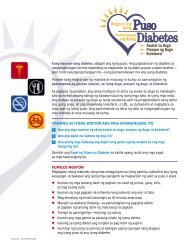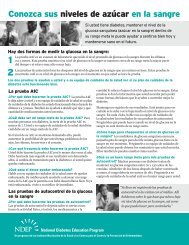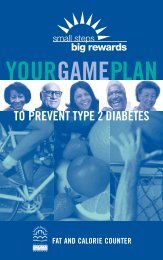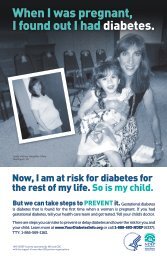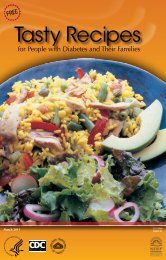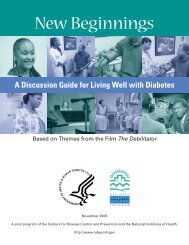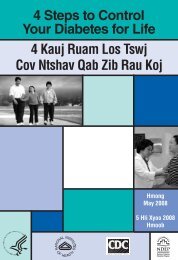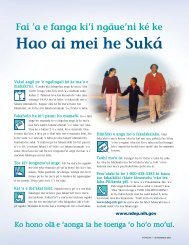Power to Prevent - National Diabetes Education Program - National ...
Power to Prevent - National Diabetes Education Program - National ...
Power to Prevent - National Diabetes Education Program - National ...
You also want an ePaper? Increase the reach of your titles
YUMPU automatically turns print PDFs into web optimized ePapers that Google loves.
Session Duration<br />
Each session is designed <strong>to</strong> last about 90 <strong>to</strong> 20 minutes. Many of the sessions may be conducted<br />
more comfortably (less hurriedly, with more time for discussion) as 20-minute sessions, if your<br />
group can meet for this long. For example, allowing 20 minutes for Session will ensure enough<br />
time for you <strong>to</strong> review materials and <strong>to</strong> have participants fll out the Pre–Session Questionnaire.<br />
Also, you may add activities, extend a discussion, or schedule feld trips that will prolong a session.<br />
All sessions should include at least a 5- <strong>to</strong> 0-minute stretch and activity break; 90-minute sessions<br />
should also have a 0-minute restroom break.<br />
Participants’ Materials<br />
It is important that you read the Group Participants’ Guide in this manual thoroughly before<br />
leading a session. You should also read the handouts that the participants will be given during the<br />
sessions and the session lesson plans). As group leader, you need <strong>to</strong> know how <strong>to</strong> use the tracking<br />
<strong>to</strong>ols, and you need <strong>to</strong> understand the instructions that you will be giving <strong>to</strong> the participants<br />
<strong>Program</strong> Preparation<br />
Decide Whom You Want <strong>to</strong> Reach; Identify and Recruit Participants<br />
Before beginning a program, ask yourself: Why am I organizing this program? Is the organization<br />
for which I work trying <strong>to</strong> reach a particular community? Am I doing this as part of a family or<br />
faith-based group? Find out as much as you can about the people whom you are trying <strong>to</strong> attract<br />
<strong>to</strong> your program. To help identify the target audience for your program, talk with community<br />
members and fnd out what they perceive as their health needs.<br />
Remember the key goal of this program is <strong>to</strong> identify people at increased risk for diabetes <strong>to</strong> help<br />
them learn behaviors that will help them lose weight and prevent or delay type 2 diabetes. How can<br />
you identify people at increased risk? You can start with the paper-and-pencil risk test in Appendix<br />
A: the <strong>Diabetes</strong> Detection Initiative Risk Test (DDI Risk Test). Create a fyer or run a newspaper ad<br />
using the DDI Risk test and inviting people with are at increased risk <strong>to</strong> come join your program.<br />
The <strong>Power</strong> To <strong>Prevent</strong> program was developed with African Americans in mind but could be used<br />
with any audience or a mixed ethnicity group.<br />
As you decide which audience <strong>to</strong> target, consider issues such as formal education, occupation,<br />
and how hard the audience may be <strong>to</strong> reach. For example, if your target audience is composed<br />
of individuals with low education and reading levels, your organization must be prepared for low<br />
literacy needs. If you choose a hard-<strong>to</strong>-reach population (e.g., the homeless), consider whether you<br />
are able <strong>to</strong> provide the additional human resources that are often needed for follow-up or <strong>to</strong> deal<br />
with social services concerns. You should weigh these fac<strong>to</strong>rs when you select your target audience.<br />
Remember that success depends not only on whom you want <strong>to</strong> reach, but also how well-equipped<br />
you are <strong>to</strong> reach them. Outreach and advertising ideas for your program will also depend on whom<br />
you are trying <strong>to</strong> attract. The approach will be different for younger or older adults or for a specifc<br />
occupational segment (e.g., blue collar workers at a particular worksite, family units through a<br />
church group, or working mothers through a community newsletter).<br />
Making Health Communication <strong>Program</strong>s Work: A Planner’s Guide (available from http://cancer.<br />
gov/pinkbook) is a handbook developed by the <strong>National</strong> Cancer Institute that presents key<br />
NDEP <strong>Power</strong> <strong>to</strong> <strong>Prevent</strong> <strong>Program</strong> Leaders Guide 8



